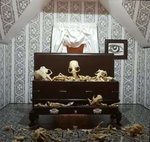

Rob Stenzel’s stop-animation film, “The Witch’s House,” harkens to the Tim Burton of the ‘90s with a hint of Bergman’s Swedish sensibility of loss and introspection.
Created as part of an open submission for the Patchogue Arts Council’s 2020 interactive art installation, “MoCA Lights” series, Stenzel’s work was selected to be shown in “Night Visions,” a pop-up projected gallery to be held in two different locations in Patchogue Village and curated by PAC chairwoman, Beth Giacummo, and gallery assistant, Eric Murphy.
From Nov. 5-8, the pop-up gallery will feature the works of over 30 local, national, and international artists at what Giacummo lovingly calls “Roe Piazza,” between the Patchogue Library and Toast.
Stenzel’s piece, the only stop-animation in the collection, is one that pulls on the tone of an endless abyss of dread intermingled with wishful levity brought on by the pandemic.
The color palette for the film—blacks, white, and neutral greys—were painted painstakingly by Stenzel, who worked up to 4 a.m., sometimes spending eight to 10 hours a day for three weeks on the project.
The patterns of the walls and floors of the house were taken from actual rubbings of gravestones from the Patchogue cemetery by the YMCA, which were then digitally seamed and laser printed at Staples, as that type of printing lends itself well to decoupage. Stenzel’s vision for the dollhouse, like much of his work, comes from his sensory-laden dreams and in this case, “machinations of the mind where the house is an attempt to go somewhere tangible.”
A religious studies major, Stenzel has learned of the stirring practices of shamanism, with concepts of death and life and funerary traditions. “A lot of cultures celebrate the connection of life and death. In our Judeo-Christian world, we fear death. In my dreams, death and birth are the same.”
Thus the interplay of staid, interrupted life captured in the animation, but the introduction of lighter elements like bubbles for a bath.
In one scene, chairs are added to a room, but in a disordered, stacking phenomenon, invoking the idea that despite our loneliness, there are always more to join, if perhaps not in the way we envisioned.
While an admitted amateur for cinema, Stenzel’s artistic talents and deftness with narrative come through in the short film, as we are introduced to an off-camera “family of one” of sorts that lives and tries to be alive in the home, despite intervals of death at each room’s gathering.
The aura of isolation is directly from Stenzel’s feelings on the pandemic, where the home has become a type of prison and daily tasks, like grooming, require more fanfare than pre-COVID.
“There is a sense of loneliness in the film, but also one of hope,” said Stenzel.
Directed and filmed without storyboards, “The Witch’s House” is one that is natural in its exploration of dark-minded, but imploringly rosy-eyed themes and austere, yet abundant aesthetic.
Comments
No comments on this item Please log in to comment by clicking here